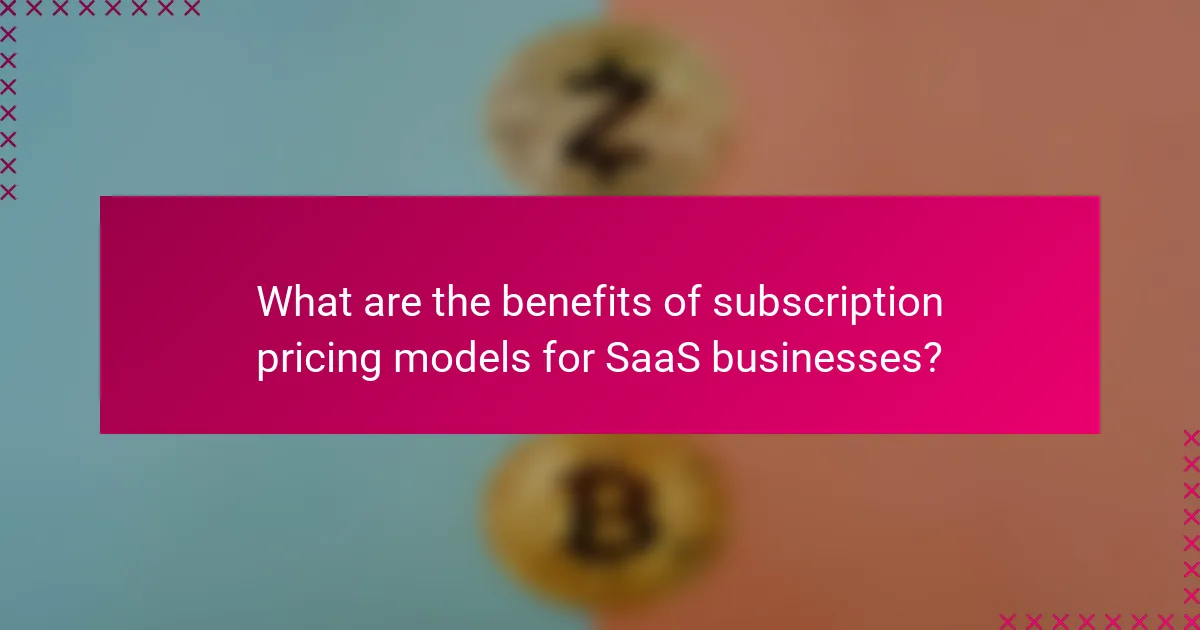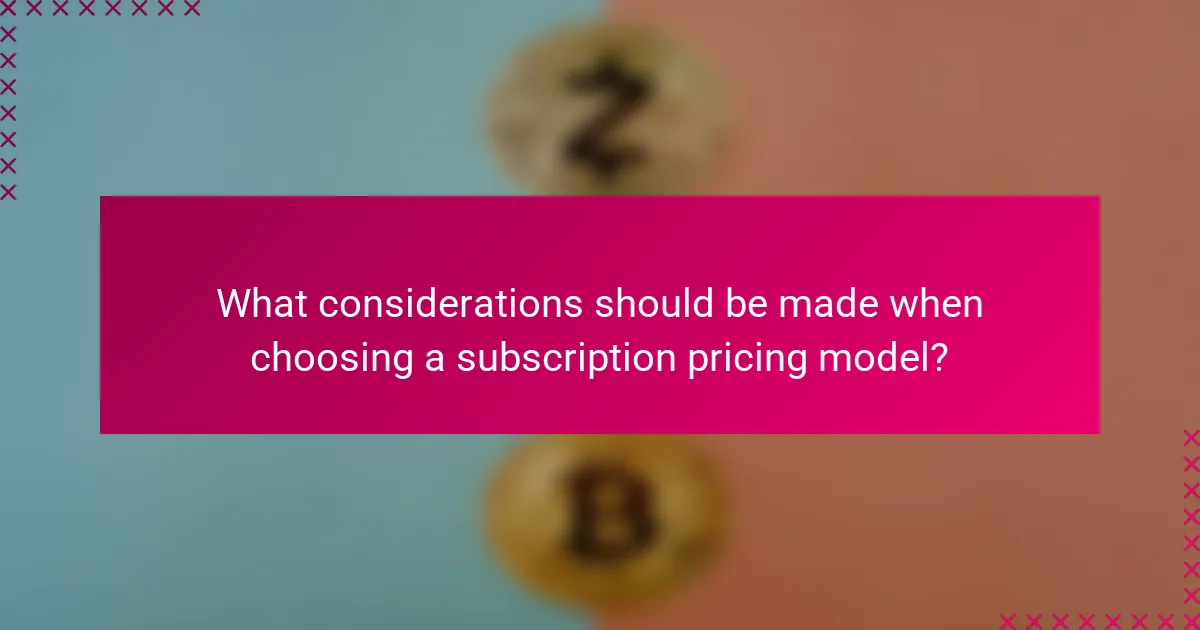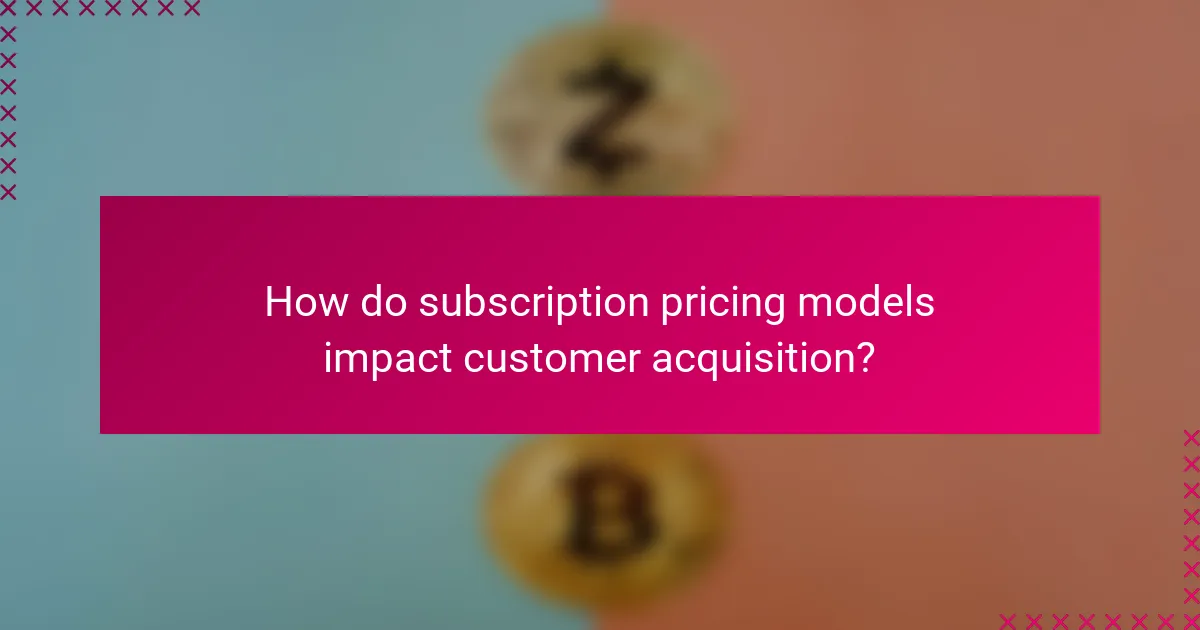Subscription pricing models have become increasingly popular in various industries, offering businesses a way to cater to diverse customer needs. These models, such as flat-rate, tiered, and freemium, provide distinct advantages like stable revenue and enhanced customer loyalty. However, selecting the right model requires a thorough assessment of your target audience, market dynamics, and overall cost structure to ensure optimal success.

What are the subscription pricing models available in Canada?
In Canada, several subscription pricing models cater to different business needs and customer preferences. These models include flat-rate, tiered, usage-based, freemium, and per-user pricing, each offering unique benefits and considerations for both providers and subscribers.
Flat-rate pricing model
The flat-rate pricing model charges a single fixed fee for access to a product or service, regardless of usage. This simplicity makes it easy for customers to understand their costs and for businesses to predict revenue.
Common examples include streaming services like Netflix, where users pay a monthly fee for unlimited access. This model is beneficial for companies looking to build a stable customer base and streamline billing processes.
Tiered pricing model
The tiered pricing model offers multiple pricing levels based on different features or usage limits. Each tier provides varying benefits, allowing customers to choose a plan that best suits their needs.
For instance, a software company might offer basic, standard, and premium plans, with increasing features at each level. This model can attract a wider audience by catering to diverse budgets and requirements.
Usage-based pricing model
In the usage-based pricing model, customers pay based on their actual consumption of a service or product. This approach aligns costs with usage, making it appealing for those who prefer to pay only for what they use.
Examples include cloud services like AWS, where charges are based on data storage and processing. While this model can lead to lower initial costs, it may result in unpredictable expenses for customers with fluctuating usage patterns.
Freemium pricing model
The freemium pricing model offers basic services for free while charging for premium features. This strategy helps attract a large user base, with the hope that some will convert to paid plans.
Popular in mobile apps and online services, this model allows users to test a product before committing financially. However, businesses must balance free offerings with enough value to encourage upgrades without overwhelming users with ads or limitations.
Per-user pricing model
The per-user pricing model charges a fee for each individual user accessing a service. This model is common in software-as-a-service (SaaS) platforms, where businesses pay based on the number of employees using the software.
This approach can be beneficial for companies that want to scale their costs with their workforce. However, it may lead to higher expenses as a business grows, so careful budgeting and forecasting are essential.

What are the benefits of subscription pricing models for SaaS businesses?
Subscription pricing models offer several advantages for SaaS businesses, including stable revenue, improved customer loyalty, and the ability to scale services efficiently. These models allow companies to predict income more accurately and foster long-term relationships with users.
Predictable revenue streams
One of the primary benefits of subscription pricing is the creation of predictable revenue streams. By charging customers a recurring fee, businesses can forecast their income more reliably, which aids in budgeting and financial planning. This stability is crucial for growth and investment in product development.
For example, a SaaS company charging $50 per month for its service can expect to generate $600 per customer annually. This predictability allows for better cash flow management and reduces the financial uncertainty that often accompanies one-time sales.
Customer retention and loyalty
Subscription models enhance customer retention and loyalty by encouraging ongoing engagement. When users commit to a subscription, they are more likely to develop a habit of using the service regularly, which can lead to higher satisfaction and lower churn rates. This ongoing relationship often results in customers valuing the service more highly over time.
Additionally, businesses can implement loyalty programs or offer exclusive content to subscribers, further incentivizing users to remain subscribed. This strategy not only retains customers but can also lead to upselling opportunities as users become more invested in the service.
Scalability and flexibility
Subscription pricing models provide scalability and flexibility, allowing businesses to adjust their offerings based on customer needs. Companies can easily introduce tiered pricing structures, enabling them to cater to different segments of the market. For instance, a SaaS provider might offer basic, standard, and premium plans, each with varying features and price points.
This flexibility allows businesses to adapt to changing market conditions and customer preferences. As a result, they can attract a broader audience while ensuring that existing customers can upgrade or downgrade their plans as needed, maintaining satisfaction and loyalty.

What considerations should be made when choosing a subscription pricing model?
Choosing a subscription pricing model requires careful evaluation of several factors, including your target audience, market competition, and cost structure. Each of these elements plays a crucial role in determining the most effective pricing strategy for your business.
Target audience analysis
Understanding your target audience is essential for selecting a subscription pricing model that resonates with them. Consider demographics, preferences, and spending habits to tailor your offerings. For instance, younger consumers may prefer lower-cost, flexible plans, while older demographics might value premium features and stability.
Conduct surveys or focus groups to gather insights about what potential subscribers find appealing. This information can guide you in setting a price point that aligns with their expectations and willingness to pay.
Market competition
Analyzing your competitors’ pricing models is vital for positioning your subscription service effectively. Look at how similar businesses structure their pricing and what features they offer at various price points. This can help you identify gaps in the market or areas where you can differentiate your service.
Consider adopting a competitive pricing strategy, which may involve setting prices slightly lower than competitors to attract new customers or offering unique features that justify a higher price. Regularly review competitors to stay informed of any changes in their pricing strategies.
Cost structure evaluation
A thorough evaluation of your cost structure is necessary to ensure that your subscription pricing model is sustainable. Calculate fixed and variable costs associated with delivering your service, including production, marketing, and customer support expenses. This will help you determine a minimum price point that covers costs while allowing for profit.
It’s also important to consider scalability. As your subscriber base grows, your costs may change. Ensure your pricing model can adapt to these changes without sacrificing profitability. Regularly revisit your cost analysis to adjust pricing as necessary based on operational shifts.

How do subscription pricing models impact customer acquisition?
Subscription pricing models significantly enhance customer acquisition by lowering barriers to entry and providing flexible payment options. These models allow customers to access products or services with minimal upfront investment, making it easier for them to try new offerings.
Lower initial costs for customers
One of the primary advantages of subscription pricing is the reduced initial costs for customers. Instead of paying a large sum upfront, customers can pay a smaller recurring fee, which can range from a few dollars to a couple of hundred, depending on the service. This lower financial commitment encourages more customers to sign up.
For example, streaming services often charge monthly fees that are significantly less than the cost of purchasing individual movies or shows. This model allows customers to explore a wide range of content without the risk of a hefty one-time payment.
Increased trial conversions
Subscription pricing models often lead to higher trial conversions because they allow customers to experience a service with minimal risk. Many companies offer free trials or introductory pricing, which can attract hesitant customers who might otherwise avoid a significant upfront investment.
For instance, software companies frequently provide a 30-day free trial of their subscription services. This strategy enables potential customers to evaluate the product’s value before committing to a monthly or annual fee, resulting in a higher likelihood of conversion.

What are the challenges of implementing subscription pricing models?
Implementing subscription pricing models presents several challenges, including managing customer churn and adjusting pricing strategies. Companies must navigate these complexities to ensure sustainable revenue and customer satisfaction.
Customer churn management
Customer churn refers to the rate at which subscribers discontinue their service. Managing churn is crucial, as high rates can significantly impact revenue. Companies should regularly analyze churn data to identify trends and reasons for cancellations.
To reduce churn, businesses can implement proactive customer engagement strategies, such as personalized communication and loyalty programs. Offering flexible subscription options or incentives for long-term commitments can also help retain customers.
Pricing strategy adjustments
Adjusting pricing strategies is essential for adapting to market changes and customer preferences. Companies may need to experiment with different pricing tiers or promotional offers to find the optimal balance between value and profitability.
Regularly reviewing competitor pricing and customer feedback can inform these adjustments. It’s important to communicate any changes transparently to customers to maintain trust and minimize dissatisfaction.

What are the emerging trends in subscription pricing models?
Emerging trends in subscription pricing models include tiered pricing, usage-based pricing, and personalized subscriptions. These models cater to diverse consumer needs and preferences, allowing businesses to enhance customer retention and optimize revenue.
Tiered Pricing Models
Tiered pricing models offer multiple subscription levels, each with varying features and price points. This approach allows customers to choose a plan that best fits their needs and budget, often leading to higher customer satisfaction and retention.
For example, a software company might offer a basic plan for individuals, a standard plan for small teams, and a premium plan for larger enterprises. This structure can help businesses capture a wider audience by appealing to different market segments.
Usage-Based Pricing
Usage-based pricing charges customers based on their actual consumption of a service, making it a flexible option for many users. This model is particularly effective for services like cloud storage or streaming, where customer usage can vary significantly.
For instance, a cloud service might charge a base fee plus additional costs for data storage beyond a certain limit. This pricing strategy encourages customers to scale their usage according to their needs, potentially leading to increased revenue for the provider.
Personalized Subscriptions
Personalized subscriptions tailor offerings to individual customer preferences, enhancing user experience and loyalty. This model often uses data analytics to understand customer behavior and recommend specific products or services.
An example could be a meal kit delivery service that adjusts its offerings based on dietary preferences and past orders. By providing a customized experience, businesses can foster stronger relationships with their customers and improve retention rates.
